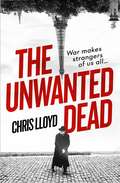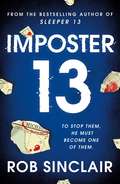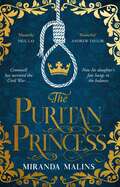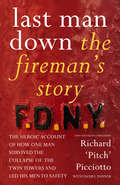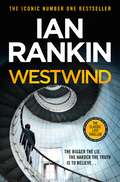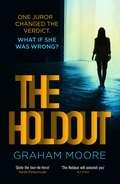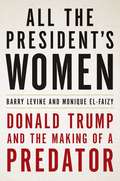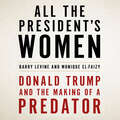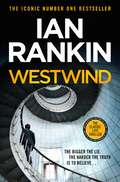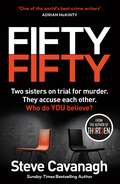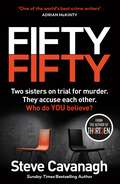- Table View
- List View
The Unwanted Dead
by Chris Lloyd'A gripping murder mystery and a vivid recreation of Paris under German Occupation.' ANDREW TAYLOR'Terrific' SUNDAY TIMES, Best Books of the Month'A thoughtful, haunting thriller' MICK HERRON'Sharp and compelling' THE SUN* * * * *Paris, Friday 14th June 1940.The day the Nazis march into Paris, making headlines around the globe.Paris police detective Eddie Giral - a survivor of the last World War - watches helplessly on as his world changes forever.But there is something he still has control over. Finding whoever is responsible for the murder of four refugees. The unwanted dead, who no one wants to claim.To do so, he must tread carefully between the Occupation and the Resistance, between truth and lies, between the man he is and the man he was.All the while becoming whoever he must be to survive in this new and terrible order descending on his home...* * * * *'Lloyd's Second World War Paris is rougher than Alan Furst's, and Eddie Giral, his French detective, is way edgier than Philip Kerr's Bernie Gunther ... Ranks alongside both for its convincingly cloying atmosphere of a city subjugated to a foreign power, a plot that reaches across war-torn Europe and into the rifts in the Nazi factions, and a hero who tries to be a good man in a bad world. Powerful stuff.'THE TIMES'Excellent ... In Eddie Giral, Lloyd has created a character reminiscent of Philip Kerr's Bernie Gunther, oozing with attitude and a conflicted morality that powers a complex, polished plot. Historical crime at its finest.'VASEEM KHAN, author of Midnight at Malabar House'Monumentally impressive ... A truly wonderful book. If somebody'd given it to me and told me it was the latest Robert Harris, I wouldn't have been surprised. Eddie Giral is a wonderful creation.'ALIS HAWKINS'A terrific read - gripping and well-paced. The period atmosphere is excellent.'MARK ELLIS'The best kind of crime novel: gripping, thought-provoking and moving. In Detective Eddie Giral, Chris Lloyd has created a flawed hero not just for occupied Paris, but for our own times, too.'KATHERINE STANSFIELD
The Best of Matt 2020: The funniest and best from the Cartoonist of the Year
by Matt Pritchett'Matt is an Adorable Genius' Jilly Cooper'So much greater than his nearest rivals it's almost embarrassing' Stephen FryThe last twelve months seen through the eyes of the brilliantly funny cartoonist Matt - the perfect Christmas gift.This year has certainly been a challenge . . .From 'unprecedented' to 'furlough', 'lockdown' to 'who even remembers Brexit', Matt is always there with exactly the right brilliantly uplifting take on the world. There is no doubt: award-winning Matt definitely makes the world a happier place!
The Best of Matt 2021
by Matt Pritchett'Matt is an Adorable Genius' Jilly CooperThe last twelve months seen through the eyes of the brilliantly funny cartoonist Matt - the perfect Christmas gift.'No one can be funny every time - except Matt' John Humphrys'So much greater than his nearest rivals it's almost embarrassing' Stephen Fry'That rare thing - a daily cartoonist who never fails' THE TIMES There is no doubt: award-winning Matt definitely makes the world a happier place!
The Best of Matt 2021
by Matt Pritchett'Matt is an Adorable Genius' Jilly CooperThe last twelve months seen through the eyes of the brilliantly funny cartoonist Matt - the perfect Christmas gift.'No one can be funny every time - except Matt' John Humphrys'So much greater than his nearest rivals it's almost embarrassing' Stephen Fry'That rare thing - a daily cartoonist who never fails' THE TIMES There is no doubt: award-winning Matt definitely makes the world a happier place!
The Best of Matt 2022
by Matt PritchettThe latest - superb - collection from everyone's favourite cartoonist! 'Matt is an Adorable Genius' Jilly Cooper'So much greater than his nearest rivals it's almost embarrassing' Stephen Fry'No one can be funny every time - except Matt' John Humphrys There is no doubt: award-winning Matt definitely makes the world a happier place!
Matt on Brexit
by Matt Pritchett'However bad the day's news, there'll still be a Matt cartoon the morning after, and we'll still laugh - he's a genius!' Jeremy Vine'Always topical and achingly funny' Jilly CooperFrom the (some say ill-judged) Referendum to the Remain and Leave campaigns with all their twists and turns ... From a vote of No Confidence to the ongoing confusion ... Matt hits the spot every time. Brilliantly entertaining, award-winning Matt can lighten even the most troubling times, and find the perfect cartoon to make the nation smile.
Matt on Brexit
by Matt Pritchett'However bad the day's news, there'll still be a Matt cartoon the morning after, and we'll still laugh - he's a genius!' Jeremy VineFrom the (some say ill-judged) Referendum to the Remain and Leave campaigns with all their twists and turns ... From a vote of No Confidence to the ongoing confusion ... Matt hits the spot every time. Brilliantly entertaining, award-winning Matt can lighten even the most troubling times, and find the perfect cartoon to make the nation smile.
Imposter 13: The breath-taking, must-read bestseller! (Sleeper 13 #3)
by Rob SinclairTHE EXPLOSIVE FINALE TO THE SLEEPER 13 SERIESAgainst all odds, Aydin Torkal - aka Sleeper 13 - broke free from the terrorist group that took him as a child and raised him into a life of violence and hate.In the two years since, he's been tracking and killing those responsible. But he's not done yet.Now living a secret life in London, MI6 needs his help infiltrating a sinister new terrorist cell. In order to halt their deadly ambitions, he must convince the world's most dangerous terrorists that he's one of them.He must do it before the world suffers another deadly attack.And he must do it alone.He is IMPOSTER 13.THE SLEEPER 13 THRILLER SERIES HAS READERS GRIPPED:'Perfect for spy thriller lovers and fans of I Am Pilgrim, Orphan X' - Goodreads review'I could not put down this book' - Netgalley reviewer'Brilliant, gripping' - Netgalley reviewer
Imposter 13: The breath-taking, must-read bestseller!
by Rob SinclairTHE EXPLOSIVE FINALE TO THE SLEEPER 13 SERIESAgainst all odds, Aydin Torkal - aka Sleeper 13 - broke free from the terrorist group that took him as a child and raised him into a life of violence and hate.In the two years since, he's been tracking and killing those responsible. But he's not done yet.Now living a secret life in London, MI6 needs his help infiltrating a sinister new terrorist cell. In order to halt their deadly ambitions, he must convince the world's most dangerous terrorists that he's one of them.He must do it before the world suffers another deadly attack.And he must do it alone.He is IMPOSTER 13.THE SLEEPER 13 THRILLER SERIES HAS READERS GRIPPED:'Perfect for spy thriller lovers and fans of I Am Pilgrim, Orphan X' - Goodreads review'I could not put down this book' - Netgalley reviewer'Brilliant, gripping' - Netgalley reviewer
The Puritan Princess: The gripping and unforgettable new historical novel of family, politics and the price of love to read in 2021
by Miranda MalinsPower, passion and a devastating fight for the crown - discover the gripping story of Oliver Cromwell's youngest daughter. Perfect for fans of Anne O'Brien, Alison Weir and Philippa Gregory 'A powerful and superbly researched historical novel' Andrew Taylor, author of The Last Protector1657. The youngest daughter of Oliver Cromwell, eighteen-year-old Frances is finding her place at England's new centre of power.Following the turmoil of Civil War, a fragile sense of stability has returned to the country. Her father has risen to the unprecedented position of Lord Protector of the Commonwealth, and Frances has found herself transported from her humble childhood home to the sumptuous palaces of Hampton Court and Whitehall, where she dreams of romance.But after an assassination attempt on the Cromwell family, Frances realises the precarious danger of her position - and when her father is officially offered the crown, Frances' fate becomes a matter of diplomatic and dynastic importance. Trapped in the web of court intrigue, Frances must make a choice. Allow herself to be a political pawn, or use her new status to take control - of her own future, and of her country's... ***Readers are swept away by The Puritan Princess:'There is much to enjoy in this evocation of a family whose lives are so upended by the convulsions of history' Antonia Senior, The Times'The Puritan Princess is a genuinely moving portrait of the tragedy of the Cromwells at the height of their power' S G MacLean, author of the Damian Seeker series'A beautifully written and captivating true story of personal love and loss... Malins inhabits her characters and brings them convincingly to life' James Evans, author of EMIGRANTS'The extraordinary, revealing and moving relationship between Oliver Cromwell and his daughter Frances is brought to vivid life in this masterly historical novel' Paul Lay, author of Providence Lost'Miranda Malins is a real and fresh new talent. This is beautifully written, exciting fiction from a writer in full command of the history' Suzannah Lipscomb'This engaging novel brings one of the most momentous but least well known periods of English history vividly to life.' Carolyn Kirby, author of THE CONVICTION OF CORA BURNS
Fighting Evil: The Ordinary Man who went to War Against ISIS
by Macer GiffordA visceral, riveting, no-holds-barred military memoir told from the front line of the war against ISIS with a foreword by Andy McNab. In the summer of 2014 the world watched in horror as the black flag of ISIS swept all before it. Mosul, the second largest city in Iraq fell, ISIS proclaimed the caliphate and the horror mounted: from the mass murder, rape and enslavement of the Yazidis to the public beheading of journalists by British jihadis. For Macer Gifford it wasn't enough to ask why more wasn't being done, he knew he had to act. So, he left his job in the city, split from his girlfriend and a few weeks later found himself illegally crossing the border into Syria to join the Kurdish YPG in their fight against the savagery of ISIS.Macer Gifford became one of longest serving British International Volunteers and one of the only few to be promoted to be a Commander in the YPG. He fought alongside the Kurds (and their Syrian Allies) for three long tours of duty from the dawn of the caliphate all the way to its military defeat in the ruins of Raqqa in 2017, sniping at the final deadly wave of suicide bombers as they burst from the rubble. Along the way, he made - and lost - many friends. This is the only complete account of the war against the Caliphate by the Kurds and the remarkable and often eccentric band of international volunteers who fought alongside them.
Fighting Evil: The Ordinary Man who went to War Against ISIS
by Macer GiffordA visceral, riveting, no-holds-barred military memoir told from the front line of the war against ISIS with a foreword by Andy McNab. In the summer of 2014 the world watched in horror as the black flag of ISIS swept all before it. Mosul, the second largest city in Iraq fell, ISIS proclaimed the caliphate and the horror mounted: from the mass murder, rape and enslavement of the Yazidis to the public beheading of journalists by British jihadis. For Macer Gifford it wasn't enough to ask why more wasn't being done, he knew he had to act. So, he left his job in the city, split from his girlfriend and a few weeks later found himself illegally crossing the border into Syria to join the Kurdish YPG in their fight against the savagery of ISIS.Macer Gifford became one of longest serving British International Volunteers and one of the only few to be promoted to be a Commander in the YPG. He fought alongside the Kurds (and their Syrian Allies) for three long tours of duty from the dawn of the caliphate all the way to its military defeat in the ruins of Raqqa in 2017, sniping at the final deadly wave of suicide bombers as they burst from the rubble. Along the way, he made - and lost - many friends. This is the only complete account of the war against the Caliphate by the Kurds and the remarkable and often eccentric band of international volunteers who fought alongside them.
Last Man Down: The Fireman's Story: The Heroic Account of How Pitch Picciotto Survived the Collapse of the Twin Towers
by FDNY Battalion C Richard 'Pitch' PicciottoThe No. 1 bestselling true story of Battalion Commander Richard Picciotto who, on 11 September, survived the collapse of the North Tower of the World Trade Center.On September 11th, Battalion Commander Richard 'Pitch' Picciotto was the highest ranking fire department commander in the twin towers when the North Tower fell. Pitch and his men were on the 17th floor racing upward when the world seemed to explode around them. From his intimate knowledge of the Towers gained during service after the 1993 WTC bombing Pitch was able to lead the firefighters to an alternative stairwell to floor 12 where they were met with a horrifying sight - more than 50 workers too crippled, too old, or too weak to have made their way out on their own. Pitch ordered his firefighters to form a human chain and pushed and cajoled them down the stairs. They were in the 7th floor stairwell when the tower fell, and Pitch and a handful of survivors woke to find themselves buried on the landing of floor 2. This is the story of how Pitch Picciotto led his men and the survivors to safety.
Chaos with Ed Miliband
by Milligan'Uncannily accurate ... a total page-turner.' ED MILIBAND 3 May 2015: 'Britain faces a simple and inescapable choice - stability and strong government with me, or chaos with Ed Miliband' David Cameron7 May 2015: David Cameron (Conservative) defeats Ed Miliband (Labour) in the United Kingdom general election, winning by 330 seats to 232. As Mr Cameron predicted, the following years for the UK were a period of incredible stability, growth and common-sense thinking, with very little bad news to report. Mr Miliband was not so lucky.In Chaos With Ed Miliband, we follow the main news stories and issues that have arisen since that election, in stark contrast to the turmoil, hardship, and downright anarchy that has occurred in Ed's life. From returning his overdue books to the library (£1.22 fine, paid in full), to drinking an espresso at 9.39pm at a dinner party to be polite (he was still awake at 2.13am), and visiting three different branches of Waitrose to find the right type of balsamic for his favourite niçoise dressing, I'm sure you'll agree, we can all be very thankful that Mr Cameron helped secure this period of stability and rock-solid government, and that we were all spared from what can only be described as chaos with Ed Miliband...
Chaos with Ed Miliband
by Milligan3 May 2015: 'Britain faces a simple and inescapable choice - stability and strong government with me, or chaos with Ed Miliband' David Cameron7 May 2015: David Cameron (Conservative) defeats Ed Miliband (Labour) in the United Kingdom general election, winning by 330 seats to 232. As Mr Cameron predicted, the following years for the UK were a period of incredible stability, growth and common-sense thinking, with very little bad news to report. Mr Miliband was not so lucky.In Chaos With Ed Miliband, we follow the main news stories and issues that have arisen since that election, in stark contrast to the turmoil, hardship, and downright anarchy that has occurred in Ed's life. From returning his overdue books to the library (£1.22 fine, paid in full), to drinking an espresso at 9.39pm at a dinner party to be polite (he was still awake at 2.13am), and visiting three different branches of Waitrose to find the right type of balsamic for his favourite niçoise dressing, I'm sure you'll agree, we can all be very thankful that Mr Cameron helped secure this period of stability and rock-solid government, and that we were all spared from what can only be described as chaos with Ed Miliband...
Westwind: The classic lost thriller
by Ian RankinTHE CLASSIC LOST THRILLER FROM THE ICONIC NUMBER ONE BESTSELLER'Shockingly good' The Sun'A prescient, high-octane thriller' Daily Express'Totally on the money - and ripe for this republication' i Newspaper * * * * *It always starts with a small lie. That's how you stop noticing the bigger ones.After his friend suspects something strange going on at the satellite facility where they both work - and then goes missing - Martin Hepton doesn't believe the official line of "long-term sick leave"...Refusing to stop asking questions, he leaves his old life behind, aware that someone is shadowing his every move. But why?The only hope he has is his ex-girlfriend Jill Watson - the only journalist who will believe his story.But neither of them can believe the puzzle they're piecing together - or just how shocking the secret is that everybody wants to stay hidden...DISCOVER THE CLASSIC LOST THRILLER FROM THE ICONIC NUMBER ONE BESTSELLER.* * * * *'Rankin is a master storyteller'Guardian'Great fiction, full stop'The Times'Ian Rankin is a genius'Lee Child'One of Britain's leading novelists in any genre'New Statesman'A virtuoso of the craft'Daily Mail'Rankin is a phenomenon'Spectator'Britain's No.1 crime writer'Mirror'Quite simply, crime writing of the highest order'Express'Worthy of Agatha Christie at her best'Scotsman
The Holdout: The tense, gripping Richard and Judy Book Club pick for 2021
by Graham Moore'The most gripping and satisfying thriller I've read in more than a decade' Sophie Hannah'One of the best legal thrillers ... as elegant and gripping as Scott Turow's Presumed Innocent' Daily Mail'Quite the tour de force! Twelve Angry Men meets Chinatown and creates something of its own' Sarah Pinborough'This is a tense, emotionally charged, scary-good, stand-out read' Caroline Kepnes**********MAJOR TV SERIES COMING SOON - FROM THE PEOPLE WHO BROUGHT YOU NETFLIX'S UNBELIEVABLE... One juror changed the verdict. What if she was wrong?'Ten years ago we made a decision together...'Fifteen-year-old Jessica Silver, heiress to a billion-dollar fortune, vanishes on her way home from school. Her teacher, Bobby Nock, is the prime suspect. It's an open and shut case for the prosecution, and a quick conviction seems all but guaranteed. Until Maya Seale, a young woman on the jury, persuades the rest of the jurors to vote not guilty: a controversial decision that will change all of their lives forever.Ten years later, one of the jurors is found dead, and Maya is the prime suspect.The real killer could be any of the other ten jurors. Is Maya being forced to pay the price for her decision all those years ago?**********'Plunge a syringe filled with adrenaline into the heart of Twelve Angry Men and you've got The Holdout: the first legal thriller in thirty years - ever since Presumed Innocent and A Time to Kill electrified readers the world over - to rank alongside those two modern classics.' AJ Finn'A page-turning legal thriller with a twisty and absolutely riveting plot ... plus a strong and compelling female heroine. You won't be able to put this one down!' Lisa Scottoline'Clever, well-written and twistier than a can of silly-string. You absolutely need to read The Holdout!' Emma Kavanagh'Amazing thriller, deserves to be one of the biggest books of 2020' Michelle Davies'Terrific, twisty and well-structured thriller' Adele Geras
All the President's Women: Donald Trump and the Making of a Predator
by Monique El-Faizy Barry LevineBased on groundbreaking original reporting, an extensive new look at Donald Trump's relationships with women, revealing new accusations of sexual misconduct, exploring the roots of his alleged predatory behavior, and illustrating how Trump's presidency has helped catalyze the #MeToo movement and revitalize women's activism.
All the President's Women: Donald Trump and the Making of a Predator
by Monique El-Faizy Barry LevineBased on groundbreaking original reporting, an extensive new look at Donald Trump's relationships with women, revealing new accusations of sexual misconduct, exploring the roots of his alleged predatory behavior, and illustrating how Trump's presidency has helped catalyze the #MeToo movement and revitalize women's activism.
Groomed to be a Bride (A Maggie Hartley Foster Carer Story)
by Maggie HartleyA heartbreaking, powerful true story from Britain's most-loved foster carer, perfect for fans of Cathy Glass and Casey Watson.When a terrified young girl is discovered hiding in the back of a lorry, she is quickly taken into the care of social services. Arriving on the doorstep of foster carer Maggie Hartley, she is painfully thin, bruised and unable to speak a word of English. What atrocities has she escaped to bring her here? Woken each night by the screams of Halima's nightmares, Maggie is desperate to reach this damaged young girl. But without a shared language, she fears that she may never uncover the truth behind her terror.Can Maggie help Halima recover from the horrors she has endured, and help her build a new life for herself? Or will Halima forever be haunted by the ghosts of her past?
Groomed to be a Bride
by Maggie HartleyA heartbreaking, powerful true story from Britain's most-loved foster carer, perfect for fans of Cathy Glass and Casey Watson.When a terrified young girl is discovered hiding in the back of a lorry, she is quickly taken into the care of social services. Arriving on the doorstep of foster carer Maggie Hartley, she is painfully thin, bruised and unable to speak a word of English. What atrocities has she escaped to bring her here? Woken each night by the screams of Halima's nightmares, Maggie is desperate to reach this damaged young girl. But without a shared language, she fears that she may never uncover the truth behind her terror.Can Maggie help Halima recover from the horrors she has endured, and help her build a new life for herself? Or will Halima forever be haunted by the ghosts of her past?
Westwind: The classic lost thriller
by Ian RankinIt always starts with a small lie. That's how you stop noticing the bigger ones.After his friend suspects something strange going on at the launch facility where they both work - and then goes missing - Martin Hepton doesn't believe the official line of "long-term sick leave"...Refusing to stop asking questions, he leaves his old life behind, aware that someone is shadowing his every move.The only hope he has is his ex-girlfriend Jill Watson - the only journalist who will believe his story.But neither of them can believe the puzzle they're piecing together - or just how shocking the secret is that everybody wants to stay hidden...A gripping, page-turning suspense masterclass - experience the brilliance of the iconic Ian Rankin.
Fifty-Fifty: The Number One Ebook Bestseller, Sunday Times Bestseller, BBC2 Between the Covers Book of the Week and Richard and Judy Bookclub pick (Eddie Flynn Series)
by Steve CavanaghPART OF BBC TWO'S BOOK CLUB BETWEEN THE COVERSTWO SISTERS ON TRIAL FOR MURDER. THEY ACCUSE EACH OTHER.WHO DO YOU BELIEVE?'911 what's your emergency?''My dad's dead. My sister Sofia killed him. She's still in the house. Please send help.''My dad's dead. My sister Alexandra killed him. She's still in the house. Please send help.'One of them is a liar and a killer.But which one?********Your favourite authors LOVE Fifty-Fifty, the follow-up to the bestselling novel Thirteen:'A terrific writer. He has talent to burn.' Don Winslow'Trust me - it will keep you guessing until the very end.' Ian Rankin'Unpredictable, daring and completely compelling. Top notch writing.' Alex North'Very clever, darkly funny, moving, fast-paced.' Jane Casey'Steve Cavanagh writes the best hooks in the business' Mick Herron'Absolutely brilliant. Addictive, clever, pacy. Eddie Flynn is one of my heroes.' Jo Spain'Intelligent, sophisticated and tense.' Mari Hannah
Fifty-Fifty: The Number One Ebook Bestseller, Sunday Times Bestseller, BBC2 Between the Covers Book of the Week and Richard and Judy Bookclub pick (Eddie Flynn Series)
by Steve CavanaghPART OF BBC TWO'S BOOK CLUB BETWEEN THE COVERSTWO SISTERS ON TRIAL FOR MURDER. THEY ACCUSE EACH OTHER.WHO DO YOU BELIEVE?'911 what's your emergency?''My dad's dead. My sister Sofia killed him. She's still in the house. Please send help.''My dad's dead. My sister Alexandra killed him. She's still in the house. Please send help.'One of them is a liar and a killer.But which one?********Your favourite authors LOVE Fifty-Fifty, the follow-up to the bestselling novel Thirteen:'A terrific writer. He has talent to burn.' Don Winslow'Trust me - it will keep you guessing until the very end.' Ian Rankin'Unpredictable, daring and completely compelling. Top notch writing.' Alex North'Very clever, darkly funny, moving, fast-paced.' Jane Casey'Steve Cavanagh writes the best hooks in the business' Mick Herron'Absolutely brilliant. Addictive, clever, pacy. Eddie Flynn is one of my heroes.' Jo Spain'Intelligent, sophisticated and tense.' Mari Hannah
Fifty-Fifty: The Number One Ebook Bestseller, Sunday Times Bestseller, BBC2 Between the Covers Book of the Week and Richard and Judy Bookclub pick
by Steve CavanaghPART OF BBC TWO'S BOOK CLUB BETWEEN THE COVERSTWO SISTERS ON TRIAL FOR MURDER. THEY ACCUSE EACH OTHER.WHO DO YOU BELIEVE?'911 what's your emergency?''My dad's dead. My sister Sofia killed him. She's still in the house. Please send help.''My dad's dead. My sister Alexandra killed him. She's still in the house. Please send help.'One of them is a liar and a killer.But which one?********Your favourite authors LOVE Fifty-Fifty, the follow-up to the bestselling novel Thirteen:'A terrific writer. He has talent to burn.' Don Winslow'Trust me - it will keep you guessing until the very end.' Ian Rankin'Unpredictable, daring and completely compelling. Top notch writing.' Alex North'Very clever, darkly funny, moving, fast-paced.' Jane Casey'Steve Cavanagh writes the best hooks in the business' Mick Herron'Absolutely brilliant. Addictive, clever, pacy. Eddie Flynn is one of my heroes.' Jo Spain'Intelligent, sophisticated and tense.' Mari Hannah
